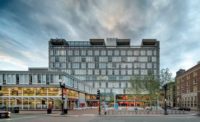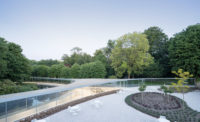Walden Pond Visitor Center by Maryann Thompson Architects
Concord, Massachusetts

The new center embodies, in a contemporary language of wood and glass, many of the principles that Henry David Thoreau advocated in his writing.
Photo © Iwan Baan

Meandering footpaths lend a sense of discovery to the building and its grounds.
Photo © Iwan Baan

A front porch, just outside the center’s entrance will be shaded with canopies spanning the framework of steel posts and black locust logs.
Photo © Iwan Baan

All of the wood— including the heat-treated ash and maple for decking and siding—was locally sourced.
Photo © Iwan Baan

The team designed flexible interiors—with floors and walls of red oak credits and ceilings of maple—that can accommodate a range of activities. Doors pivot to open up an exhibition/meeting space to the entry area. Triple-glazed windows admit ample daylight.
Photo © Iwan Baan

The team designed flexible interiors—with floors and walls of red oak credits and ceilings of maple—that can accommodate a range of activities. Doors pivot to open up an exhibition/meeting space to the entry area. Triple-glazed windows admit ample daylight.
Photo © Iwan Baan

Image courtesy Maryann Thompson Architects







Architects & Firms
Every year, about half a million people visit Walden Pond in the historic town of Concord, just west of Boston. Most come to hike, swim, or picnic in a rural setting. Some also pay homage to the life and work of the writer and naturalist who made the place famous. That was Henry David Thoreau, who built a tiny house here in 1845 and described his simple life in a book called Walden that became an American classic.
Additional Content:
Jump to credits & specifications
This year is the 200th anniversary of Thoreau’s birth. It’s being marked at Walden by the arrival of a fascinating new work of architecture. Known as the Walden Pond Visitor Center, it was designed by Boston architect Maryann Thompson and landscape architect Chris Matthews of Michael Van Valkenburgh Associates.
Thoreau’s one-room house vanished long ago (there is now a replica at the pond). The new visitor center, though, shares two of the house’s qualities: it’s not very big and it’s very ambitious. It seeks to embody, in a contemporary architecture of wood and glass, a lot of the principles that Thoreau advocated in his writing.
The 6,000-square-foot center sits within a state park and replaces a one-time residence, used as a ranger station, that offered little in the way of information or services. The designers pick up Thoreau’s notion that architecture should look as if it has grown as organically as landscape. You approach the building on foot on a path that isn’t quite straight. The center in the distance is half hidden among masses of new planting, and, as the route bends, the building seems to play hide-and-seek with you. There are similar glimpses—but only glimpses— of Walden Pond. You feel you’re exploring on your own, discovering places that aren’t presented as destinations but, rather, as casual events along a rural path. To use one of Thoreau’s favorite words, you’re “sojourning” in the landscape.
Sustainability is another Thoreauvian virtue. It’s manifested here in a group of outdoor benches that were formed from the trunks of live oaks. For more than a century, the trunks were deliberately submerged in the muck of Boston Harbor, in order to preserve them (I’m not kidding) for possible use in reconstructing the historic naval frigate USS Constitution. Retrieved for a new use here at Walden, they become emblems of a conservation ethic while also linking with American history.
All the wood in the center is locally sourced. Instead of importing weatherresistant timber from tropical rainforests, the designers used heattreated ash and maple for outdoor decking and siding. Indoors, an information desk and other furnishings are crafted from the wood of trees that were cut down to expand the building site. Part of the parking lot is roofed with solar panels that shade the cars while soaking up the sun. Windows are tall and bring in abundant daylight. Triple glazing and super-thick insulation keep net energy consumption near zero (this summer, the center has been selling energy to the grid).
Up close, the center has something of the look of a building still under construction. Framing members of unpainted wood surround much of the building like a layer of scaffolding, shading windows and terraces and enlivening the facades. Says Maryann Thompson, “I admire the experience of landscape seen through architecture.”
The center’s plan is organized like that of a human body. You enter at the head, an informally shaped space where walls and floors of red oak are flooded with daylight from high windows, and ceiling beams sometimes collide overhead like trees. This is the center’s major volume, the intended future home of an exhibition on Thoreau being developed by ObjectIDEA of Salem, Massachusetts.
A double-loaded corridor spine orders the rest of the building. There’s a multipurpose event hall for meetings, lectures, and the like. This summer, it’s been showing the teaser for a film on Thoreau being made by Ken Burns. Then come a bookstore and a strip of offices for the rangers. Out of sight from the center is a grim older building that offers changing rooms for swimmers.
Would Thoreau be happy with a visitor center? For a cranky, independent- minded guy, might it feel a little hokey? My guess is, he’d love it. He was a very American propagandist who wrote and published books and essays because he wanted to persuade people of better ways to live. His life at Walden was an attempt to educate by example. So is the new visitor center.
Thoreau is sometimes mythologized as a loner hermit. But recent scholars depict an active man with many friends who, even while living at Walden, continued to help his father run the family pencil business. He went to jail rather than pay his taxes when he felt the government was supporting racism and slavery. His actions encouraged such 20th-century figures as Gandhi and Martin Luther King to engage in the kind of nonviolent political protest for which Thoreau coined the term “civil disobedience.”
Walden Pond, though, is mostly about a different side of Thoreau. He was one of the first Americans to study the environment as a science. He measured and catalogued plants and animals, and his notes on such subjects as the thickness of ice at Walden Pond are helpful today in assessing the history of global warming. He wasn’t an architect, of course, but he was a surveyor and part-time homebuilder who was fascinated by structural systems such as the skeletons of birds. He’s honored here by a piece of architecture that remembers and reflects his ideals.
CreditsArchitect: Maryann Thompson Architects, 741 Mount Auburn Street, Watertown, MA, 617-744-5187, www.maryannthompson.com
Personnel in architect's firm who should receive special credit: Maryann Thompson FAIA, Zac Cardwell AIA LEED AP
Interior designer: Maryann Thompson Architects
Engineers Structural: RSE Associates Inc. MEP/FP: Garcia, Galuska & DeSousa, Inc. Civil: Nitsch Engineering
Consultants Masterplanning: Crosby | Schlessinger | Smallridge Landscape Architecture: Michael Van Valkenburgh Associates, Inc. Specifications: Kalin Associates Inc. Code: Hughes Associates LEED: The Green Engineer, Inc. PV Canopy Design and Engineering: Solar Design Associates, LLC Cost Estimating: VJ Associates Exhibit Planning: Object Idea
General contractor: Stutman Contracting Inc.
Solar Array contractor: Ostrow Electric Co.
Photographer: Iwan Baan
Clients: Massachusetts Department of Conservation and Recreation; Massachusetts Division of Capital Asset Management and Maintenance
|
SpecificationsStructural System SIPs (roof): Foard Panel, Inc. Heavy Timber Frame: Ponders Hollow
Exterior Cladding Thermally Modified Maple Siding: Ponders Hollow
Roofing Metal Standing Seam Roof: Firestone
Windows Wood frame: Bildau and Bussmann
Doors Wood Frame Entrances: Bildau and Bussmann Metal doors: De La Fontaine Wood doors: VT Industries
Hardware Locksets: Schlage Closers: LCN Exit devices: Yale Pulls: Ives Security devices: DMP
Interior Finishes Acoustical ceilings: Armstrong Cabinetwork and custom woodwork: Michael Humphries Woodworking Paints and stains: PPG Red Oak Interior Wall Siding: Ponders Hollow Solid surfacing: Caesarstone Floor and wall tile: Crossville Resilient flooring: Forbo Red Oak Flooring: Ponders Hollow
Furnishings Exterior Chairs and Interior Wood Benches: Michael Humphries Woodworking
Lighting Track Lighting: Tech Lighting Ceiling Fans: Haiku Downlights: Beta Calco Inc., LaMar Lighting, Juno Lighting Recessed Downlights: Nora Lighting Exterior: Bega Dimming system or other lighting controls: Encelium
Plumbing Water Closets: Sloan Urinals: Sloan Flushometers: Sloan Lavatories: Sloan Faucets: Symmons, Chicago Faucets Water Fountain: Elkay
Energy Building Management System: Tridium Photovoltaic panels: Upsolar Solar Hot Water System: HTP |














